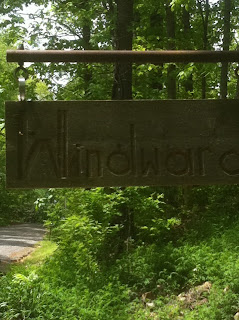 This week I will be posting a review of the Piney Branch-Piney Bridge hike that Chris, Tom and I did on Sunday. For now, I will leave it as having been a pretty rigorous trail, for several reasons – including the heat, which was in the ‘90’s. Today, a short post on the wildlife we saw…there was, indeed, plenty to behold both in rumors of encounters and in actual encounters.
This week I will be posting a review of the Piney Branch-Piney Bridge hike that Chris, Tom and I did on Sunday. For now, I will leave it as having been a pretty rigorous trail, for several reasons – including the heat, which was in the ‘90’s. Today, a short post on the wildlife we saw…there was, indeed, plenty to behold both in rumors of encounters and in actual encounters.It all began with our rendezvous in the Elk Wallow wayside’s parking lot. There was a lady standing next to her car waving her cigarette, talking to Chris, telling him that a deer had been hit on the drive nearby. That might not be an infrequent event – I’ve had some close calls in the dusk hours myself up there - but the tale just got taller.
She said that “those kids over there” said they’d seen a bear, which evidently had caught scent of the blood and started nosing around the area of the accident. I looked over to where the kids were – there were two ranger vehicles with them; I decided this part was made up, although I will give the lady credit, she was just repeating something she thought she’d heard. See, locking down two rangers in a wayside parking lot with a bear on the loose - on the hunt, even - on one of the busiest visitor weekends of the year just didn’t make sense.
Chris and Tom got busy outfitting themselves and I continued to observe the events going on around us. “Those kids” the lady mentioned were hanging around a mini-van with Ohio plates. The radiator grill was all busted apart with a few pieces just barely hanging on. The owner, maybe those kids’ dad, was reaching around under the hood…my guess, trying to get the thing road-worthy again after a deer strike.
While he was there, he heard the mini-van owner talking to the kids. “Now you kids – how many times have I told you all how to behave in front of the cops?” he said. “We got enough on our heads without you kids bringing more trouble. There’s going to be a whuppin’ later on after all this is finished up!”
After 20 minutes and one breakfast sammich later, we were at the trailhead trying to make sense of that scene for a few minutes. Well, just some hard luck with a family on a little recreational weekend, we decided, and we were underway.
Getting to the real wildlife that we encountered, a large toad was the first animal we saw. That was unusual for me in the Park. I’ve run into lots of other creatures but never a toad, and this was a good sized one. There were plenty of insects around, so he was probably pretty contented on that stretch of path.
The ribbon snake in the photo that accompanies this post was the next animal. You know, snakes aren’t the most popular animal in the forest because they are so sneaky. You’re not looking for them, and suddenly there they are, popping up in just the place you want to sit down to have lunch.
So in a sense, running into a ribbon snake was a lucky encounter, rather than an unlucky one. They’re not venomous; and at an average of two feet long – as this one was – they’re not very threatening. So we kept an eye on it over there, maybe two yards away, while we took a lunch break.
Eventually it slithered on away. My book on snakes (Amazon link below) says the ribbon snake likes the environment we were in there at that spot, near a stream, in the cool shade of a forest. I’d make a note that as far as I can tell, no snake native to these United States that is striped lengthwise is venomous. So if you encounter a snake with that coloring, try to enjoy the encounter rather than run terrified and screaming away.
We also ran into one of my favorites, a ring-neck snake. Here is a link to a photo of one that I found next to the pool: http://hawksbillcabin.blogspot.com/2008/08/battle-of-species-snakes-in-pool.html. These little guys – the size ranges up to 18 inches long, although the ones I have seen have only been six inches or so – are hunters, like many reptiles, if you can believe that. Their meals are mostly bugs, so they’re another friend in the forest.
When we finished the hike, we were de-accessioning our gear at the trailhead and a ranger drove by. He stopped to chat about conditions on the trail, making sure everything was okay with us and other hikers. We were superior, but tired.
But since he was chatty, I did ask him about the bear story. He said his shift had begun at noon (the bear situation would have been before 8am, I’m guessing), but if something like that had happened he would have heard. So it was just a tall tale, although the ranger did say, “Oh yeah, there have been plenty of bears about lately!”
We decided to head out of the Park by way of Elk Wallow again. It was crowded, but as we parked, I saw the derelict mini-van sitting there, probably waiting for parts, or for a tow. No sign of those kids or their carefully law-abiding dad. Then we were on our way.





























